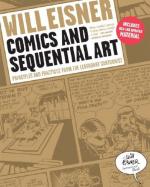
|
| Name: _________________________ | Period: ___________________ |
This test consists of 15 multiple choice questions and 5 short answer questions.
Multiple Choice Questions
1. What does the storyteller want to cause the reader to do?
(a) To become self-aware.
(b) To become isolated.
(c) To become involved.
(d) To become extremist.
2. What advantage do film and theater have of an audience that is forced to do what?
(a) Charge per viewing.
(b) View the action as presented.
(c) Press rewind and play buttons.
(d) Sit quietly.
3. How can a panel be diagrammed?
(a) Like a word.
(b) Like a song lyric.
(c) Like a railroad track.
(d) Like a sentence.
4. Expression becomes an alphabet when it undergoes what process?
(a) Chrysallis.
(b) Transmutation.
(c) Codification.
(d) Symbolification.
5. What characteristic of a sentence acts as framing with lines in comics?
(a) Roots.
(b) Calligraphy.
(c) Morphemes.
(d) Punctuation.
6. What is another word for panels?
(a) Hearts.
(b) Bows.
(c) Bubbles.
(d) Boxes.
7. What particular changes in sound does calligraphy relate to?
(a) Changes in heart palpitations.
(b) Changes in inflection and sound levels in speech.
(c) Changes in vocal patterns.
(d) Changes in pressure of vocal strings and ink.
8. When are the outlines determined by the artist?
(a) After the artist decides on the action.
(b) After the rest of the comic is drawn.
(c) While the artist draws the page.
(d) Before the artist decides on the action.
9. Around when did daily comic strips first appear?
(a) 1756.
(b) 1956.
(c) 1934.
(d) 1943.
10. Stories can be told through what alone?
(a) Focal points.
(b) Signatures.
(c) Spirit.
(d) Imagery.
11. As a language, what do comics need to utilize?
(a) A pair of ears.
(b) A pen and ink.
(c) A message.
(d) A grammar.
12. What do different renderings require from the viewer?
(a) Inference and trained memorization.
(b) Time.
(c) Lesser or greater memory and deduction.
(d) Good eyesight.
13. As artists tell stories to mass audiences, what do they use as means of arrangement?
(a) Triangles.
(b) Boxes.
(c) Bubbles.
(d) Trapezoids.
14. What are these artists trying to arrange?
(a) Complex thoughts, sounds, actions, and ideas.
(b) Power and wealth.
(c) Neural synapses.
(d) Simple questions.
15. What novelty can suggest dimension and involve the reader/viewer better than a regular container?
(a) Using 3D imagery.
(b) Using doorways or windows to frame a panel.
(c) Using accompanying CDs to explain the pages.
(d) Using rulers to structure lines clearly.
Short Answer Questions
1. What do people learn to measure distance by?
2. What characteristic of comics examines how the sequential artist works with space and time?
3. In the third example in a "Contract with God," the heavy lettering is above what creature?
4. After which century, did artists start to depend on expressions, postures, and backdrops?
5. Why does Eisner analyze this particular Spirit story in Chapter 3?
|
This section contains 441 words (approx. 2 pages at 300 words per page) |

|




